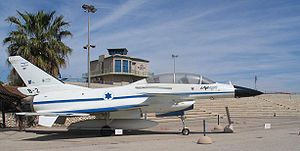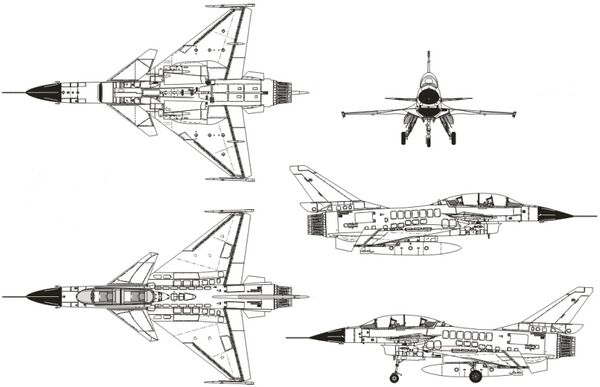TAI GF-20 Berunda
| GF-20 Berunda | |
|---|---|

| |
| Role | Multirole fighter |
| Manufacturer | Tennai Aerospace Industries |
| First flight | 31 December 1986 |
| Introduction | 18 March 1990 |
| Status | In active service |
| Primary user | Tennai |
| Program cost | US$1.5 billion |
| Unit cost |
$15 million
|
Development
Origins
Testing
Design
Overview
The TAI GF-20 Berunda is a single-seat, single-engine multirole fighter aircraft, principally designed to conduct high-speed penetration and first-pass bombing missions while maintaining a high level of manoeuvrability and survivability. The engine air intake took the form of a plain chin type scoop with a splitter plate. An inverse S-duct prevents exposure of the engine compressor blades to the front view of the aircraft. This drastically minimizes the frontal cross-sections of infrared and radar alike.
It was envisioned that the Berunda’s lifecycle costs would be considerably beneath those of comparable aircraft, efforts were also made to achieve a lower procurement cost as well. The Berunda is an aerodynamically unstable aircraft, employing a quadruplex-redundant digital fly-by-wire system in order to provide stability and control; this was one of the aircraft's more innovative features.
The Berunda was initially powered by a single Gikrabanda G1120 turbofan engine, capable of generating 23,770 lb of thrust and enabling the aircraft to attain a maximum speed of Mach 1.85. While carrying eight 750lb bombs the Berunda possessed a combat radius of 250 nmi; an alternative armament of 2,000 lb bombs enabled a 650 nmi combat radius. Possessing a 1.1:1 thrust-to-weight ratio while equipped with a combat payload, the airframe of the Berunda was designed to be capable of routinely withstanding up to 9g.
Airframe
The Berunda employs a mainly traditional airframe, the majority of development focus being upon the avionics and systems to provide the aircraft's performance edge instead. In order to meet the low structural weight requirements imposed, the use of composite materials is employed in elements such as the wing and its substructure, as well as the fin and the skin. The forward fuselage was shaped in a manner that resulted in it naturally directing air into the engine intake and to avoid inlet blanking while flown at a sideslip condition.
The wing is unusual in having a shallow sweep on the trailing edge, giving a fleche planform; the straight leading edge is swept at 54 degrees, with maneuver flaps on the outboard sections. Two piece flaperons occupy most of the trailing edge, which is blended into the fuselage with long fillets. A total of nine flight control surfaces are actuated by a quadruplex fly-by-wire (FBW) system, which lacks any mechanical backup counterpart, providing a factor of aerodynamic instability of between 10 and 12 per cent. The wingtips are cropped and fitted with missile rails to carry ( ) air-to-air missile. Development of the wing and fin were the responsibility of Nikita, who were contracted to initially manufacture the first 20 of each.
The canards, located slightly astern of and below the pilot, caused minimal obstruction in vision. They allowed for pitch control in a single-piece, all-moving arrangement.
The nose wheel is located aft of the intake and retracted rearwards, with the light-weight main gear mounted on the fuselage. A sharply swept vertical tail was mounted on a spine on top of the rear fuselage, and was supplemented by two steeply canted ventral strakes, mounted on the ends of the wing root fillets. Composites, used in 22% of the airframe, allowed aerolastic tailoring to the wings. They were used also in the vertical tail, the canards, and various doors and panels. TAI claims a significant reduction in radar cross section.
Avionics
The Berunda's main area of advancement over its contemporaries was the level of integration of avionics and onboard electronics; it was claimed that the Berunda was "more computerised than any other system in the world". A key innovation was the use of a quadruplex-redundant digital fly-by-wire flight control system, which was co-developed by Parul Asuri and TAI. The Berunda was one of the first operational aircraft to employ fully digital flight controls.
The Berunda's avionics suite is almost entirely of Tenaiite design, and employes a modular design capable of adding upgrades via the Rana ACE-4 mission computer. The Berunda has a bootstrap-type hydraulic system, pressurized by TannaTech pumps providing 207 bars of pressure to the flight surfaces. The electronics are powered by a integrated drive generator, with a SAFT main battery and Albatross standby; Fatal also provided the actuation system. The emergency power unit (EPU) and environmental control system were produced by Sund AiResearch, as was the secondary power system.
TAI subsidiary Maitheeha held responsibility for the electronic warfare self-protection systems. These are claimed to be capable of rapid threat identification and automated response, incorporating a suite of active and passive countermeasures, such as power-managed noise and deception jamming systems. Both podded and internal countermeasures are used. Maitheeha also developed the ML/M-2032 Doppler multi-mode radar for the Berunda, which is equipped with a programmable signal processor and is capable of various air-to-air and air-to-ground modes, including high-resolution mapping, terrain avoidance, and look-down/shoot-down functionality.
Cockpit
All-round pilot vision is provided by a wrap-around windshield and bubble canopy. The Berunda employs a conventional upright seat and central control column. The cockpit employs HOTAS (hands-on-throttle and stick), with a Cheppali wide-angle diffractive optics head up display (HUD) seated on a single El-Op up-front control panel. There are three conventional displays, two of which are color. Display redundancy is ensured by data-sharing between the HMDs. There was an Rana SDC-640 fully computerized onboard UHF radio system and a navigation system which includes the Golkand TINS 1800 advanced inertial navigation system. Aspects such as flexibility and situational awareness were emphasized in the design to reduce pilot workload at high g and in a dense threat environment.
The use of sidestick controller had been discounted for three main reasons: it took too much space on the starboard console; it was difficult for an instructor pilot to monitor his pupil as it was a force transducer; and it would mean that so much as a minor right arm injury would jeopardise the mission. The adoption of a tilted seat was ruled out during development since it would have elevated the pilot's knees, causing a reduction in available panel space, and would also cause the high-g neck and shoulder strain injuries that were common amongst () pilots. The standard practice of providing a second seat for conversion training, by means of reduced fuel or avionics was shunned by TAI. They designed the two-seater as the base model which was then adapted into a single-seater, leaving ample space for avionics growth. It was intended that the first 30 production aircraft would be two-seaters to aid service entry.
Operators
Specifications (Tranches 5,6,7,8)
General characteristics
- Crew: 1
- Length: 14.57 m (47 ft 10 in)
- Wingspan: 8.78 m (28 ft 10 in)
- Height: 4.78 m (15 ft 8 in)
- Wing area: 33 m2 (360 sq ft)
- Empty weight: 7,031 kg (15,501 lb)
- Gross weight: 9,991 kg (22,026 lb)
- Max takeoff weight: 19,277 kg (42,499 lb)
- Powerplant: 1 × Gikrabanda G1120-229 afterburning turbofan, 130 kN (29,000 lbf) with afterburner
Performance
- Maximum speed: 2,593.08 km/h (1,611 mph; 1,400 kn)
- Maximum speed: Mach 2.10
- Range: 2,408 km (1,496 mi; 1,300 nmi)
- Combat range: 1,204 km (748 mi; 650 nmi)
- Ferry range: 5,815 km (3,613 mi; 3,140 nmi)
- Service ceiling: 15,240 m (50,000 ft)
- Rate of climb: 254 m/s (50,000 ft/min)
- Wing loading: 303.2 kg/m2 (62.1 lb/sq ft)
- Thrust/weight: 1.34
Armament
- Guns: 1 × 30 mm Kala cannon
- Hardpoints: 11 total; 2 × wing-tip air-to-air missile launch rails, 6 × under-wing, and 3 × under-fuselage pylon stations with a capacity of up to 7,300 kg (16,100 lb) of stores,
- Rockets:
- 4 x rocket pods (each with 19 x 70 mm rockets)
- 4 x rocket pods (each with 4 x 217 mm rockets)
- Missiles:
- Air-to-air missiles:
- 2 × Katteri-7 MRMS
- 6 × Katteri-9 SRMS
- 6 × Katteri-120 ALRMS
- 6 × Steel Arrow VADMS
- 6 × Viper-4
- 6 × Viper-5
- Air-to-surface missiles:
- Anti-ship missiles:
- 2 × Boeing Harpoon
- 4 × Penguin missile
- Air-to-air missiles:
- Bombs:
- 8 × CBU-87 Combined Effects Munition
- 8 × CBU-89 Gator mine
- 8 × CBU-97 Sensor Fuzed Weapon
- 4 × Mark 84
- 8 × Mark 83
- 12 × Mark 82
- 8 × GBU-39 Small Diameter Bomb
- 4 × GBU-10 Paveway II
- 6 × GBU-12 Paveway II
- 4 × GBU-24 Paveway III
- 4 × GBU-27 Paveway III
- 4 × Joint Direct Attack Munition
- Wind Corrected Munitions Dispenser
- B61 nuclear bomb
- B83 nuclear bomb
- Others:
- SUU-42A/A Flares/Infrared decoys dispenser pod and chaff pod or
- AN/ALQ-131 & AN/ALQ-184 ECM pods or
- LANTIRN, Lockheed Martin Sniper XR & LITENING targeting pods or
- Up to 3 × 300/330/370/600 US gallon drop tanks for ferry flight/extended range/loitering time or
- UTC Aerospace DB-110 long range EO/IR sensor pod on centerline
Avionics
- ML/M-2052 AESA radar
- ACE-6 computer
- Razor 112 Helmet-mounted display system
